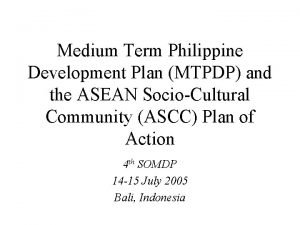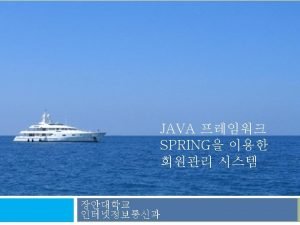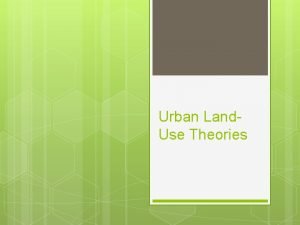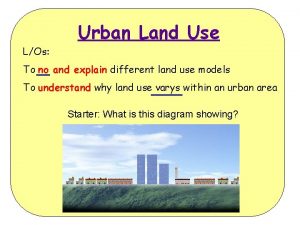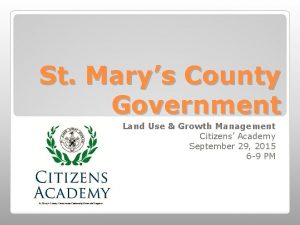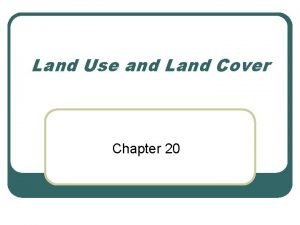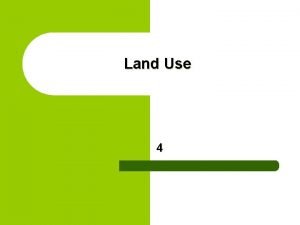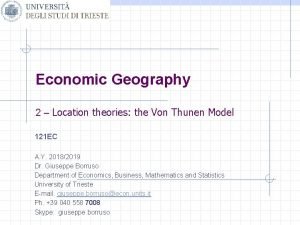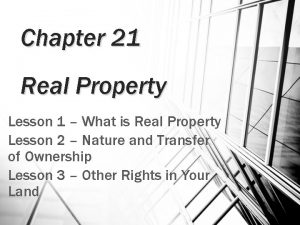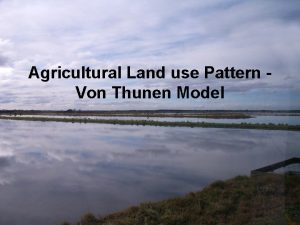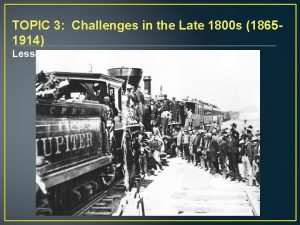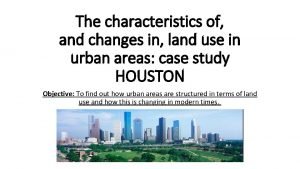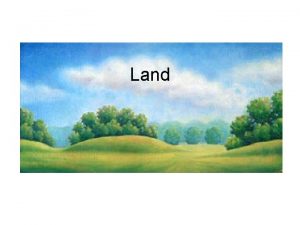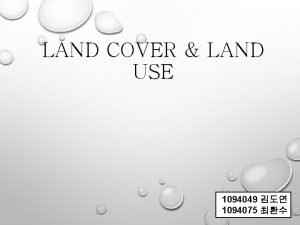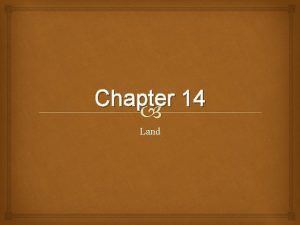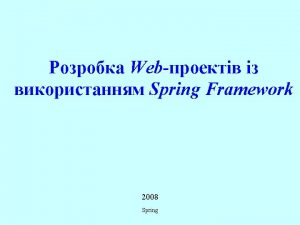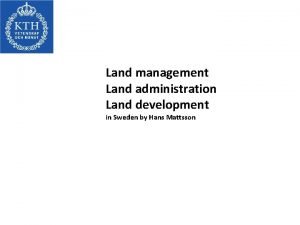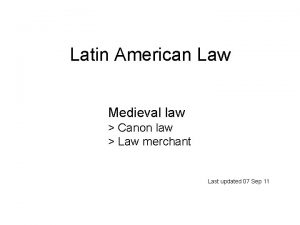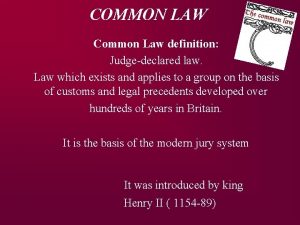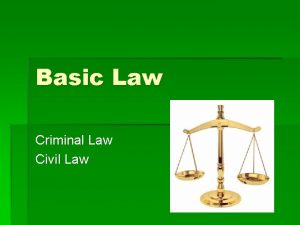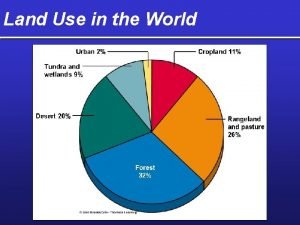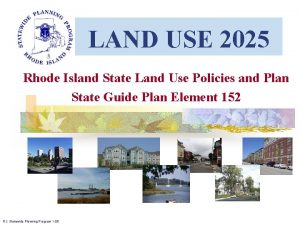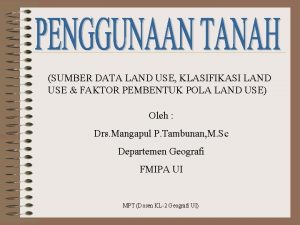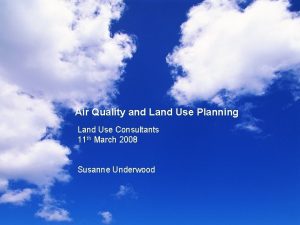Land Development Project Land Use Law Spring 2004



























- Slides: 27

Land Development Project Land Use Law Spring 2004 Mark Spykerman

u Land Development Project 1. The Proposal 2. The Current Zoning 3. The Zoning Process

1. The Proposal

New Urbanist Light Commercial Storefronts right up against sidewalk. u On street parking only (will depend heavily on pedestrian traffic) u Possible Uses u – Coffee shop – Specialty Retail


Location Vacant gas station at southeast corner of Delmar at North & South. u Located in University City, ½ mile north of downtown Clayton u

The neighbors u u Commercial Uses directly South (dry cleaner) Commercial Uses at all corners of the intersection.

The neighbors, con’t. u u High Density Residential (Zoned HR) on North & South Medium Density residential (MR) along Delmar

2. The Current Zoning

University City Zoning Map

Proposed Project’s Current Zoning: Limited Commercial

Limited Commercial u Section 34. 35. 2 Intent and purpose. The "LC" limited commercial district is intended to accommodate limited retail and service businesses at locations within or adjacent to residential neighborhoods. Such retail and service establishments are intended to serve a relatively small and local market area, or are of such character and intensity which are compatible with the surrounding neighborhood. (Ord. 6139 § 1 (Exh. A (part)), 1997) u Section 34. 35. 3 Permitted Uses – Ordinance lists 20 specific uses allowed in LC districts, including retail specialty shops. u Section 34. 35. 4 Conditional Uses – Ordinance lists 18 conditional uses including restaurants and outdoor seating. u Section 34. 94. 2 Schedule of off-street parking space requirements. – Coffee Shop requires 1 spot for every 50 sq feet of customer floor space – Retail specialty requires 1 spot for every 200 sq feet of retail space

Density and Dimensional Regulations u Section 34. 35. 5 Density and dimensional regulations. u Building Setback Requirements. – a. Minimum Right-of-way Setback. Except as provided for in Article 5, "Supplementary Regulations, " Division 34 -55, no building shall be located within thirty-five (35) feet of a street right-of-way, unless no parking areas are located between the street right -of-way and any principal or accessory building. Under these conditions, the minimum setback may be reduced to fifteen (15) feet. – b. Minimum Property Line Setback. No building setback is required from a property line, other than a right-of-way line, except where a lot abuts a residential district or abuts an alley right-of-way which separates the lot from a residential district. Under these conditions, the minimum building setback requirement shall be fifteen (15) feet from the applicable property line(s). Also see Article 5, "Supplementary Regulations, " Division 3460, for screening requirements. Where a property line setback is not required, but a building is set back off the property line, then it shall be set back at least five feet. u Modification of Property set back – Ordinance specifically calls for set back modifications to be addressed through conditional use permits instead of variances. – Impact to adjacent residential use must be considered before set back modification will be allowed.

3. The Zoning Process

Issues u Conditional Use permit for coffee shop – (Specialty retail is a permitted use) u Modification of set back requirement requires a conditional use permit u Variance for the off street parking requirement

Conditional Use permit u Conditional uses are those types of uses which tend to be problematic because they; (1) have a tendency to generate significant traffic volumes and/or turning movements, (2) have operational characteristics that may have a detrimental impact on adjacent or nearby properties, or (3) have other characteristics which may impact public health, safety, or welfare; but can be approved if such uses meet the criteria established herein. In order to ensure that detrimental impacts are avoided or mitigated to a satisfactory level, conditional uses must be reviewed, approved and issued a Conditional Use Permit. www. ucitymo. org/planning

Applying for a conditional use permit. u Required Application Materials: – Application – Memo describing property, proposed use, impact to adjacent properties – Site plan and Artist’s rendering u Required Procedures: – Public hearing with planning commission – Notice to general public (publication in newspaper) – Notice to residents within a 185 foot radius (by mail) – Staff report by Zoning Administrator

Approving a conditional use permit u The Planning Commission can recommend to the City Council to grant a conditional use permit if it finds the proposed use: – 1. Complies with all applicable provisions of the Zoning Code; – 2. At the specific location will contribute to and promote the community welfare or convenience; – 3. Will not cause substantial injury to the value of neighboring property; – 4. Is consistent with the Comprehensive Plan, neighborhood development plan (if applicable), and any other official planning and development policies of the City; and – 5. Will provide off-street parking and loading areas in accordance with the standards contained in Article 7 of the Zoning Code. u The City Council can then approve, deny or modify the conditional use permit after considering the Planning Commission’s recommendations. The Council can also table the application and ask the Planning Commission for further study.

Why the City Council should approve the conditional use permit application to allow a coffee shop u While conformity with other zoning and off-street parking requirements will depend on approval of variances, the nature of the proposed project will benefit the welfare of the immediate area. It will provide convenient amenities to residents of neighboring dense residential developments and will not negatively affect property values. Moreover, the proposed project is consistent with the comprehensive plan and will aesthetically blend with the surrounding community.

Why the City Council should approve a conditional use permit to modify the set back requirement u u The zoning ordinance requires a 15 foot set back, but the proposed project only has room for a 10 foot setback. However, our 10 foot set back will be buffered with evergreen trees, reducing any impact to neighboring residential uses. The screening is otherwise in conformity with the screening requirements between residential and non-residential uses.

Variances u Variance is a "variation" from the requirements of the Zoning Code for a certain type of construction or use. Variances are granted by the Board of Adjustment (a panel of University City residents) and are discretionary types of relief granted to property owners when they cannot meet the minimum requirements of the Zoning Code. Variances are only granted in special situations (see Section VI. Standards for Granting Variances). They should be viewed only as a last resort option. Variances basically allow the recipient to be permitted to violate a city zoning ordinance while all other citizens must still be required to abide by it. That is why Variances should only be granted when conditions at the subject property are so unusual and atypical that they warrant such special treatment. www. ucitymo. org/planning

Applying for a variance u Required Application Materials: – Application – Memo describing proposed project and potential impact of granting the variance – Site Plan – Any additional information requested by the Zoning Administrator u Required Procedures: – Public hearing before the Board of Adjustment – Notice to general public (newspaper) – Notice to neighbors within a 185 foot radius (mail)

Standards for approving a variance u Section 34 -142. 4 requires that the Board of Adjustment shall not grant a Variance unless it shall, in each case, make specific written findings of fact directly based upon the particular evidence presented to it that support the following conclusions: – 1. The Variance requested arises from a condition which is unique to the property in question and which is not ordinarily found in the same zoning district, and is not created by an action or actions of the property owner or the applicant; – 2. The strict application of the provisions of the Zoning Code from which a Variance is requested will constitute unnecessary hardship upon the property owner represented in the application; – 3. The Variance requested will not adversely affect the adjacent properties or public health, safety, order, convenience, or general welfare of the community; and – 4. Granting the Variance desired will not violate the general spirit and intent of the Zoning Code. u The burden of proof is on the applicant to show all of these criteria are satisfied.

Standards for approving a variance, con’t. u In determining whether the evidence presented supports the findings required on the previous slide (by Section 34142. 4), the Board of Adjustment shall consider the extent to which the evidence demonstrates that: – 1. The particular physical surroundings, shape, or topographical condition of the property involved would result in a practical difficulty or unnecessary hardship upon or for the owner, lessee, or occupant, as distinguished from an inconvenience, if the provisions of the Zoning Code were literally enforced; – 2. The request for a Variance is not based primarily upon the desire of the owner, lessee, occupant or applicant to secure a greater financial return from the property; – 3. The granting of the Variance will not be materially detrimental or injurious to other property or improvements in the neighborhood in which the property is located; and – 4. The proposed Variance will not impair an adequate supply of light or air to adjacent property, substantially increase the congestion in the public streets, increase the danger of fire, endanger the public safety, or substantially diminish or impair property values within the neighborhood.

Off street parking variance u Zoning ordinance requires: – 1 spot for every 50 sq feet of customer space in the coffee shop – 1 spot for every 200 sq feet of retail floor space for retail specialty uses u Proposed project allows only limited employee off street parking

Why the Board of Adjustment should grant a variance u u u 1. Strict application of the zoning ordinance would constitute hardship on the property owner because the lot is too small to develop in an economically viable way and still meet parking requirements. 2. The requested variance will not negatively affect adjacent properties and will actually be a community asset to the neighboring residents. 3. The current on street parking facilities (along Delmar and North & South) are adequate to provide for site-generated parking needs without substantially increasing congestion.

If all else fails…amend the zoning code.
 Kim ki duk spring summer fall winter
Kim ki duk spring summer fall winter Summer autumn winter
Summer autumn winter Medium term development plan philippines
Medium term development plan philippines Newton's first law and second law and third law
Newton's first law and second law and third law Newton's first law and second law and third law
Newton's first law and second law and third law Boyle's law charles law avogadro's law
Boyle's law charles law avogadro's law Avogadro's law constant
Avogadro's law constant Newton's second law spring
Newton's second law spring Dynamic web project spring 설정
Dynamic web project spring 설정 Spring mvc 게시판
Spring mvc 게시판 Spring mvc project 없음
Spring mvc project 없음 An area of land largely enclosed by higher land
An area of land largely enclosed by higher land Identifying landforms
Identifying landforms Cetacean
Cetacean Hoyt and burgess model
Hoyt and burgess model Model urban land use
Model urban land use St. marys county land use and zoning lawyer
St. marys county land use and zoning lawyer Land use planning lecture notes
Land use planning lecture notes Dpms hmda
Dpms hmda Usgs land use classification
Usgs land use classification Types of land use
Types of land use Mixed land use ap human geography definition
Mixed land use ap human geography definition Bid rent theory
Bid rent theory Irrevocable rights to some limited use of another's land
Irrevocable rights to some limited use of another's land Sinclair model of agriculture
Sinclair model of agriculture Which use of western land negatively affected everyone?
Which use of western land negatively affected everyone? Characteristics of land use in urban areas
Characteristics of land use in urban areas Land use planning lecture notes
Land use planning lecture notes


